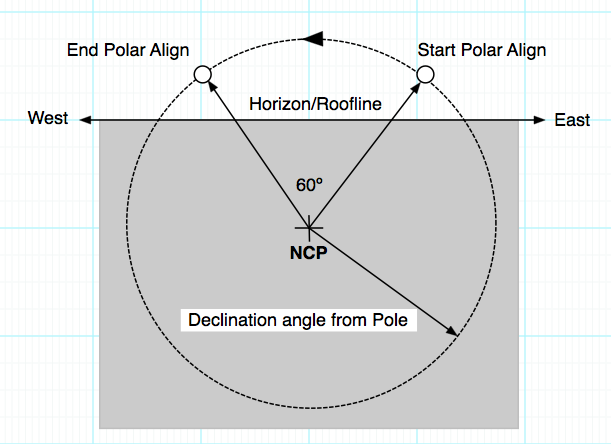In a different thread on this Forum, I have been discussing how one can use the ASIAIR Polar Alignment tool even when the pole is not visible. I decided to run my mount simulator to try to get an idea how far off in declination can we go before errors become too large (since I noticed a degradation when ZWO first released Polar Alignment in ASIAIR.
In the documentation, ZWO had recommended that you start polar alignment with the OTA positioned at top dead center with respect to the polar axis (i.e., what is called the "counterweight towards ground" position, and with declination set to +90º (northern hemisphere). ASIAIR will then rotate the RA axis by about 60º to find the center of rotation, and thus centerline of the RA axis by using two plate solves, once before the rotation, and one after the rotation.
The RA axis position in the sky is then compared to the actual North Celestial Pole (NCP) South Celestial Pole and with further plate solves, instruct you how to pull the RA axis towards the pole.
The truth of the story is that you do not need to start at the top dead center position, and therein lies the clue of how you can polar align with the NCP below a roofline or below the horizon. IN some posting, ZWO has mentioned that the polar alignment plate solves will be successful up to 30 degrees in declination from the pole (DEC=+60º in the northern hemisphere).
Because of this fact, you can start polar alignment with the OTA positioned 30º in hour angle east (i.e., -2 hours HA), and let ASIAIR slew the 60º to end up at 30 degrees in hour angle west (i.e., +2 hours HA). You can further position the declination axis so that you can clear the roofline or horizon (but no more than 30º.
This is shown in the following drawing:

Notice that the NCP can be completely under the horizon or the roofline when you do this. There is a limit though, the declination circle has to be less than 30º for ASIAIR to plate solve. Moreover, the polar alignment error gets larger as the declination angle becomes larger.
The advantage of using my mount simulator is that there is no mechanical components involved. And I can start the simulator with the virtual polar axis pointed right at NCP.
http://www.w7ay.net/site/Applications/MountSim/
To measure the polar alignment error (i.e., what ASIAIR claims to be the error when the mount is already perfectly aligned), I had used the +/- 30 degrees in hour angle I mentioned earlier. If your horizon or roofline is not horizontal, you might want to start not at 30 degrees, but at 25 degrees, for example (i.e., the gray area in the above diagram is tilted).
This is what I found:

One arc minute of polar alignment error is very usable for short (e.g., 500mm) focal lengths and short exposure times (e.g., 180 seconds). If you are autoguiding, the guide star will remain fixed on your plate, and polar alignment error will cause other stars to revolve around the guide star over time. But the streaks will be very small if you keep the exposure time short, and/or the focal length short.
By the way, ASIAIR polar alignment does not care if there is a tree or chimney in between the starting plate solve and the ending plate solve. ASIAIR only needs a clear plate at the two extremes of the 60º slew. So that is another way to judiciously pick the starting and ending hour angles to avoid obstructions.
Declinations of more than 15º from the pole is not quite ideal (more than an arc minute error), but will be better than nothing for people using DSLR and short OTAs.
Chen